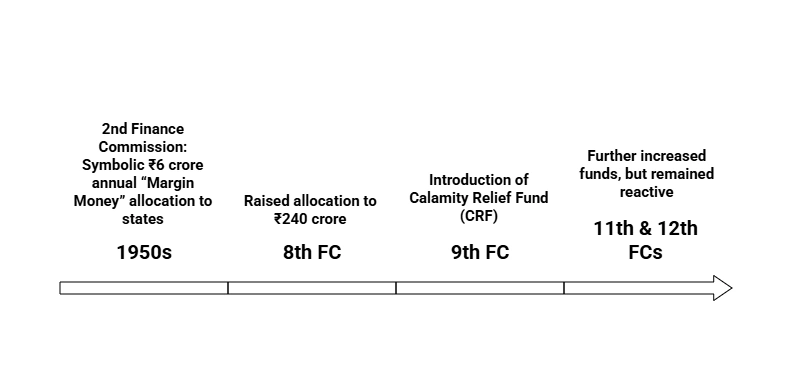Paper: GS – III, Subject: Environment, Ecology and Disaster Management, Topic: Disaster Management, Issue: Strengthening disaster risk financing.
Context:
Disaster risk financing (DRF) in India faces severe challenges. It underscores the need for proactive, structured, and innovative financial mechanisms to build climate and disaster resilience.
Key Highlights:
Rising Vulnerability and Costs:
- Increasing Disaster Frequency: India faces recurrent disasters like cyclones, floods, landslides, and extreme rainfall.
- Economic Impact: Economic losses from disasters have been assessed upwards of ₹50,000 crores annually.
- Urbanization Woes: Poor urban planning has turned cities into flood traps.
Disaster Financing in India:

Institutional Framework:
- Disaster Management Act, 2005: Provided legal backing for disaster governance.
- 13th FC: Institutionalized the National & State Disaster Response Funds (NDRF & SDRF).
- Introduced structured, rule-based financing for relief and response.
Innovations by the 15th Finance Commission:
- Timeframe: 2020–21 to 2025–26.
- Key Allocations: ₹1.6 trillion total, ₹68,000 crore to states, ₹45,000 crore for Centre.
- New Ideas:
- Build not Build Back approach.
- Adoption of Disaster Risk Index (DRI) for data-driven allocation.
- Incentives for welfare-linked risk reduction and resilient planning.
Limitations of Current System:
- Rapid Urbanization: Increased exposure to disasters.
- High Cost of Disasters: Often forces borrowing from multilateral institutions like MDBs.
- Delayed Relief: Current financing models lack the speed for immediate response.
- Neglected Area: Preparedness and mitigation remained underfunded.
Further measures needed:
- Risk Retention Tools: Contingency buffers and Emergency funds.
- Risk Transfer Models: Catastrophe risk pools and Sovereign insurance mechanisms.
- New Paradigms: Culture of self-protection and preparedness and Risk-informed planning for resilient infrastructure (housing, agriculture, etc.).
Conclusion:
Disaster risk financing is no longer just a humanitarian issue it’s about Fiscal prudence and Sovereignty over disaster recovery. It aligns with Prime Minister’s 10-point agenda, especially point 6 (financial preparedness) and point 9 (international cooperation).
La Excellence IAS Academy, the best IAS coaching in Hyderabad, known for delivering quality content and conceptual clarity for UPSC 2025 preparation.
FOLLOW US ON:
◉ YouTube : https://www.youtube.com/@CivilsPrepTeam
◉ Facebook: https://www.facebook.com/LaExcellenceIAS
◉ Instagram: https://www.instagram.com/laexcellenceiasacademy/
GET IN TOUCH:
Contact us at info@laex.in, https://laex.in/contact-us/
or Call us @ +91 9052 29 2929, +91 9052 99 2929, +91 9154 24 2140
OUR BRANCHES:
Head Office: H No: 1-10-225A, Beside AEVA Fertility Center, Ashok Nagar Extension, VV Giri Nagar, Ashok Nagar, Hyderabad, 500020
Madhapur: Flat no: 301, survey no 58-60, Guttala begumpet Madhapur metro pillar: 1524, Rangareddy Hyderabad, Telangana 500081
Bangalore: Plot No: 99, 2nd floor, 80 Feet Road, Beside Poorvika Mobiles, Chandra Layout, Attiguppe, Near Vijaya Nagara, Bengaluru, 560040

